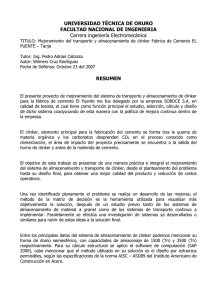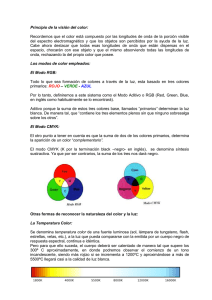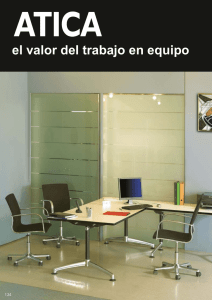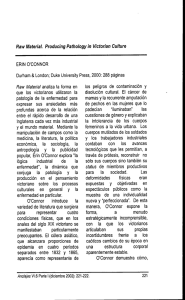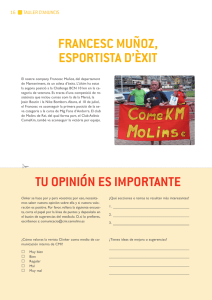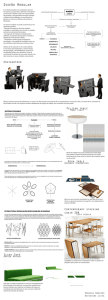Diseño factorial en la investigación de la reactividad de los
Anuncio
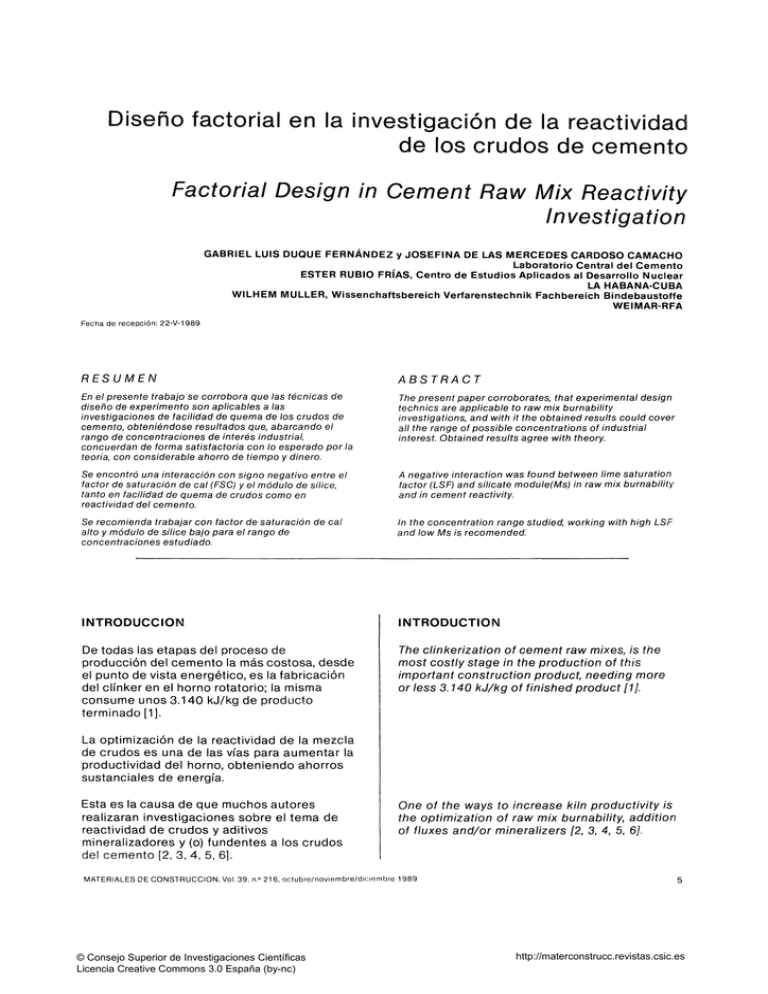
Diseño factorial en la investigación de la reactividad
de los crudos de cemento
Factorial Design in Cement Raw Mix Reactivity
Investigation
GABRIEL LUIS DUQUE FERNÁNDEZ y JOSEFINA DE LAS MERCEDES CARDOSO CAMACHO
Laboratorio Central del Cemento
ESTER RUBIO FRÍAS, Centro de Estudios Aplicados al Desarrollo Nuclear
LA HABANA-CUBA
WILHEM MULLER, Wissenchaftsbereich Verfarenstechnik Fachbereich Bindebaustoffe
WEIMAR-RFA
Fecha de recepción: 22-V-1989
RESUMEN
ABSTRACT
En el presente trabajo se corrobora que las técnicas de
diseño de experimento son aplicables a las
investigaciones de facilidad de quema de los crudos de
cemento, obteniéndose resultados que, abarcando el
rango de concentraciones de interés industrial,
concuerdan de forma satisfactoria con lo esperado por la
teoría, con considerable ahorro de tiempo y dinero.
The present paper corroborates, that experimental design
technics are applicable to raw mix burnability
investigations, and with it the obtained results could cover
all the range of possible concentrations of industrial
interest. Obtained results agree with theory.
Se encontró una interacción con signo negativo entre el
factor de saturación de cal (FSC) y el módulo de sílice,
tanto en facilidad de quema de crudos como en
reactividad del cemento.
A negative interaction was found between lime saturation
factor (LSF) and silicate module{f\As) in raw mix burnability
and in cement reactivity.
Se recomienda trabajar con factor de saturación de cal
alto y módulo de sílice bajo para el rango de
concentraciones estudiado.
In the concentration range studied, working with high LSF
and low Ms is recomended.
INTRODUCCIOM
INTRODUCTIOfSI
De todas las etapas de! proceso de
producción del cemento la más costosa, desde
el punto de vista energético, es la fabricación
del clinker en el horno rotatorio; la misma
consume unos 3.140 kJ/kg de producto
terminado [1].
The clinkerization
of cement raw mixes, is trie
most costly stage in the production of this
important construction product, needing more
or less 3.140 l<J/kg of finished product [1].
La optimización de la reactividad de la mezcla
de crudos es una de las vías para aumentar la
productividad del horno, obteniendo ahorros
sustanciales de energía.
Esta es la causa de que muchos autores
realizaran investigaciones sobre el tema de
reactividad de crudos y aditivos
mineralizadores y (o) fundentes a los crudos
del cemento [2, 3, 4, 5, 6].
One of the ways to increase kiln productivity is
the optimization of raw mix burnability,
addition
of fluxes and/or mineralizers [2, 3, 4, 5, 6].
MATERIALES DE CONSTRUCCIÓN, Vol. 39. n.° 216, octubre/noviembre/diciembre 1 989
© Consejo Superior de Investigaciones Científicas
Licencia Creative Commons 3.0 España (by-nc)
http://materconstrucc.revistas.csic.es
Estos trabajos analizan los efectos del aditivo
o de determinada mezcla con una composición
fija pero, desde el punto de vista industrial, es
necesario estudiar el comportamiento de estos
aditivos en el rango de concentraciones en
que fluctúan, el factor de saturación de cal
(FSC), el módulo de sílice (Ms) y el módulo de
alúmina (Ma) [7].
In this papers the effect of additives or some
mix of fixed composition is analyzed, but in an
industrial point of view, it is necesary a
thorough study of all the range of
concentrations in which the lime saturation
factor (LSF), silicate and alumina modules of
the investigated raw mix move [7].
Henning [8] encontró que existía una
correlación entre el espectro infrarrojo y el
contenido de alita de las distintas fases del
cemento.
Henning [8] found a correlation between the
infrared espectra and the different phases
content in cement.
Yamaguchi et al [9], propusieron el máximo de
difracción que se encuentra, entre 2,715 y
2,885 angstroms, para evaluar el contenido de
alita de un cemento.
Yamaguchi et al [9], proposed cement alite
content evaluation through the difraction
maximum at 2.715-2.885
angstroms.
En [7] se demostró que las técnicas de diseño
de experimento son aplicables a este tipo de
investigaciones, y el objetivo del presente
trabajo es el estudio de la interrelación de las
técnicas instrumentales con las técnicas de
diseño de experimento.
In [7] it was demonstrated that this technics
were applicable in this sort of investigation and
the objectives of the present paper are the
relationships between theory,
instrumental
technics and experimental
design.
DESARROLLO DEL TRABAJO
EXPERIMENTAL PROCEDURE
Se prepararon 6 muestras de crudo de
alimentación al horno en los que se variaron
los módulos y el FSC en el rango de trabajo de
la fábrica, obteniéndose los resultados que se
presentan en la tabla 1.
Six raw mixes were elaborated with different
LSF, silicate module (Ms), and alumínate
module (Ma), that cover the working range of
the factory, obtaining the results shown in
table 1.
TABLA 1
TABLE 1
Composición química de las diferentes muestras (Chemical composition of the diferent samples)
Parámetros de los
crudos (Parameters i
oí the raw mix)
Contenidos en % en masa (Contents in mass %)
Muestra
(Sample)
SiO^
AIA
Fe,03
CaO
MgO
PPI
FSC
Ms
Ma
1
13.5
4.2
2,7
40,5
0.9
35.2
0,92
1.95
1.55
2
13,2
4.1
2,6
40,7
1.2
35.2
0.94
1.94
1.58
3
13.8
4.1
2,6
40.6
0,9
35,1
0,90
2,08
1.57
4
13.2
3.9
2.5
41.0
0,8
35,3
0,95
2,06
1.57
5
13.5
4.3
2,3
40.4
1.0
35.1
0.91
2,02
1,80
6
13.1
4.0
2,3
41.3
0,9
35,7
0.94
1,99
1.72
Las variables fueron codificadas, de tal forma
[10], que con un subconjunto de cuatro de las
seis muestras elaboradas se pudiera estudiar
el efecto del FSC y el Ms (muestras 1, 2, 3 y 4),
y con otro el efecto del FSC y el Ma (muestras
1, 2, 5 y 6), con lo que se obtienen dos diseños
factoriales 2^.
1
The variables were coded in such a way [10]
that with a subset of four of the six samples,
the effect of LSF and Ms could be studied
(samples 1, 2, 3 and 4) and with the another
the effect of LSF and Ma could be studied
(samples 1, 2, 5 and 6). Then there are two 2^
factorial design experiments.
MATERIALES DE CONSTRUCCIÓN. Vol. 39. n." 216. octubr()/noviemt)re/diciembre 1989
© Consejo Superior de Investigaciones Científicas
Licencia Creative Commons 3.0 España (by-nc)
http://materconstrucc.revistas.csic.es
Los valores de los parámetros para la
codificación se muestran en la tabla 2.
The coding values for the different
are shown in table 2.
Todas las muestras fueron calcinadas por el
método descrito en [7], obteniéndose
clinkeres cuya composición aparece en la
tablas.
All the samples were ignited by the method
described in [7], obtaining clinkers with
compositions shown in table 3.
TABLA 2
parameters
TABLE 2
Codificación de las variables (Variables
codification)
Variable (Variable)
Valor menor (-1) [Lower value (-1)]
Valor mayor (+1) [Higher value (+1)]
FSC (LSF)
0.90-0.92
0,94-0.96
Ms
1,94-2,02
2.06-2,08
Ma
1,55-1.58
1.72-1.80
TABLA 3
TABLE 3
Composición química, mineralógica y contenido de fase líquida de los clinkeres
(Chemical, mineralogical and liquid phase contents of the studied clinkers)
Contenidos en % en masa (Contents in mass %)
Muestra
(Sample)
SIO^
AI2O3
Fe,03
CaO
MgO
0!
1
21,8
6.8
4.4
65.5
1.5
0,94
2
21.5
6.6
4.2
65.9
1,9
0.91
3
22,3
6,5
4.2
65,5
1.5
1,17
4
21,5
6,4
4,1
66.7
1.3
1.47
5
21.9
7,0
3.9
65,6
1.6
1.31
6
21,3
6.5
3,8
67.0
1.4
1.11
Muestra
(Sample)
Composición mineralógica según Bogue
(Bogue mineralógicas contents)
Contenidos de fase líquida
a la temperatura de
(Liquid phase contents
at the temperature of)
C3S
C^S
C3A
C4AF
1.340
1.400
1.500
1
45.1
28.5
0,6
13,4
28.3
31.2
31.8
2
50.4
23.6
0.4
12,8
27.5
30,6
31.2
3
42.7
31,7
0.1
12,8
27.1
29.9
30,4
4
52,2
21.4
0.1
12.5
26,3
29,2
29.7
5
42.7
30.6
2,0
11.9
25.4
29.6
30,2
6
57.2
18.0
0.6
11.6
24.6
29,9
29.4
'
MATERIALES DE CONSTRUCCIÓN, Vol.39, n.« 216. octubre/noviembre/diciembre 1989
© Consejo Superior de Investigaciones Científicas
Licencia Creative Commons 3.0 España (by-nc)
http://materconstrucc.revistas.csic.es
Los clínkeres fueron evaluados en cuanto al
"contenido de alita" por espectroscopia
infrarroja y por difracción de rayos X. Además,
se observaron por microscopía óptica con luz
reflejada en un microscopio Metallux 3 y se le
determinó el contenido de cal libre a muestras
calcinadas a distintas temperaturas.
The "alite content" was evaluated by X ray
diffraction [9] and by infrared
espectroscopy
181
These sample were also studied by optical
microscopy with a Metallux 3 microscope and
their free lime was chemically
determined.
A los cementos elaborados a partir de ellos se
les determinó el contenido de agua fija (grado
de hidratación), para lo cual se elimina el agua
no combinada por un tratamiento con alcohol
isopropílico, seguido de acetona y
calentamiento a 110 grados celsios. Al
producto así obtenido se le determina la
pérdida por ignición, que se relaciona con la
resistencia a compresión alcanzada por
morteros de cemento sin adición, con
coeficientes de correlación mayor de 0,90 [11].
Cements were elaborated with this clinkers and
were used in fixed water (degree of hydration)
determination [11]. For this the noncombined
water is eliminated by treatment with isopropyl
alcohol followed of acetone and heating at 110
degrees Celsius. The product thus obtained is
ignited and the lost on ignition is relationed
with the compresive strength developed by
cement mortar with correlation
coeficient
greater than 0,90 [11].
RESULTADOS
RESULTS
Con los valores de fase líquida que se
muestran en la tabla 3, y aplicando el diseño
propuesto, se obtienen las ecuaciones
siguientes:
From the values of the liquid phase, and using
the proposed model, the next equations were
obtained.
ai34o (Xi , X^) = 27,3 - 0,4 X, - 0,6 X^
(1)
a,34o (Xi , X3) = 2 6 , 4 - 0 , 4 X, - 1 , 4 X 3
(2)
ai4oo (Xi , X2) = 30,2 - 0,3 X, - 0,7 X^
(3)
ai4oo (X, , X3) = 30,1 - 0,3 X, - 0.8 X3
(4)
aM5o (X, , X,) = 30,8 - 0,3 X, - 0,7 X^
(5)
ai45o (X, , X3) = 30,6 - 0,4 X, - 0.8 X3
(6)
Donde ay es la cantidad de fase líquida en % a
la temperatura de "y" grados celsios; X^ es el
valor codificado para el factor de saturación de
cal; X2 es el valor codificado para el módulo de
sílice; X3 es el valor codificado para el módulo
de alúmina.
Where ay is the quantity of liquid phase in % at
the temperature of "y" celsius degrees.
X7 is the coded value for LSF.
X2 is the coded value for Ms.
Xo is the coded value for Ma.
Utilizando las ecuaciones propuestas por
Henning [8] y los máximos de difracción
propuestos por Yamaguchi et al [9], se estimó
el "contenido de alita", mostrándose los
resultados en la tabla 4 y, al aplicar el diseño
propuesto a los valores obtenidos, se encontró:
Using the equations proposed by Henning [8]
and the maximum of diffraction proposed by
Yamaguchi ¡9], "alite content" was estimated,
the results are shown in table 4.
— Por el método infrarrojo:
— Using infrared
With this values the next equations
calculated:
were
method:
Y = 2615 + 1415 X, - 419 X, X,
(7)
Y = 2245 + 1105 X, - 684 X3
(8)
MATERIALES DE CONSTRUCCIÓN, Vol. 39. n." 216. octubre/novlembro/diciombre 1989
© Consejo Superior de Investigaciones Científicas
Licencia Creative Commons 3.0 España (by-nc)
http://materconstrucc.revistas.csic.es
Por difracción de rayos X:
|
— Using X ray diffraction method:
Y = 22,25 + 3,23 X, - 1,79 X, Xg
(9)
Y = 21,4 + 1,2 X, - 0,9 X3
TABLA 4
(10)
TABLE 4
Estinnación del contenido de alita por las distintas técnicas
(Estimation of "alite content" by different technics)
Muestra (Sample)
DRX
IR
1
21.0
1.085
2
23,5
4.773
3
21,9
1.310
4
22.6
3.293
5
21.6
1.107
6
19,4
994
Donde DRX es el área del máximo de difracción en centímetros cuadrados e IR es el valor obtenido de las ecuaciones de
regresión propuestas por Henning utilizando espectroscopia infrarroja.
Donde Y es el "contenido relativo de alita"; X^,
X2 y X3 toman, respectivamente, el mismo
significado que en el caso anterior.
Where Y is "alite content" X^, X2 and X3 fa/ce
respectively the coded values of LSF, Ms and
Ma.
Como se puede observar, las ecuaciones
obtenidas por ambos métodos son similares
en cuanto a su forma general.
As it could be seen this equations are of a
similar form.
Al carecer de patrones adecuados, no
pudieron calibrarse los equipos, motivando
que las ecuaciones sólo sean indicativas de la
variación del contenido de alita.
The equipment could not be calibrated
because of the lack of standards. Making this
equations only indicative of the variation of
"alite content".
Los resultados del contenido de cal libre, de
las muestras calcinadas a distintas
temperaturas, se muestran en el tabla 5.
The free lime of the samples ignited at
different temperatures are shown in table 5.
Con esos valores, y aplicando el diseño
propuesto, se calcularon las ecuaciones
siguientes:
with this values the next equations were
calculated.
% CI,5o (X, , X2) = 21,6 + 1,8 X, + 0,8 X, X2
(11)
% 01,50 (Xi , X3) = 21,5 + 0,7 X, - 0,3 X3 + 0,8 X, X3
(12)
% CI,2oo (X, , Xg) = 12,0 + X, - 1,1 X2 - 0,8 X, X2
(13)
% CI,2oo (X, , X3) = 12,3 + 0,6 X, - 0,9 X3 + 0,8 X, X^
(14)
% CI,3oo (X, , X2) = 1,2 + 0,4 X, + 0,3 X, X,
(15)
%CI,3oo(X, , X3) = 1,5 + 0 , 4 X, X3
(16)
% C U ( X i .X,) = 1,1 + 0 , 2 X 2
(17)
% C U ( X , . X3) = 1,1 + 0 , 1 X3
(18)
MATERIALES DE CONSTRUCCIÓN, Vol. 39, n.° 21 6, octubre/noviembre/diciembre 1989
© Consejo Superior de Investigaciones Científicas
Licencia Creative Commons 3.0 España (by-nc)
http://materconstrucc.revistas.csic.es
TABLA 5
TABLE 5
Contenido de cal libre de las muestras calcinadas a distintas temperaturas
Fre lime contents of samples ignited at different
temperatures
% de cal libre en la muestra Free lime contents in mass %)
Temperatura
calcinación
(Ignition
temperature)
1
2
3
4
5
6
950
20,84
22.85
23.87
18.72
20.85
21.53
1.100
16.18
17,73
14,14
14.75
15,00
14,36
1.200
11,31
14.98
10.72
11.14
12.09
10,71
1.220
10.86
12.38
10,55
9.29
10,43
10,52
1.250
5.40
10.78
5.87
6,37
6.04
5,90
1.300
1,11
2.23
1.00
0.76
1.61
1.02
1.350
1.20
2.17
0,79
0.67
0,57
1,06
1.400
0.94
0.91
1.17
1.47
1,31
1.11
1
Donde % Cly es el contenido de cal libre que
se obtiene en una muestra calcinada a la
temperatura de "y" grados celsios y las demás
variables toman los valores de los casos
anteriores.
Wiiere % Cly is the free lime contents in the
ignited samples at "y" celsius degrees, the
other variables take the same value of the
foregoing
equations.
Por otro lado se obtuvieron clínkeres
calcinando gradualmente las muestras desde
temperatura ambiente hasta 1.400 grados
celsios, con los cuales se elaboraron
cementos cuyas composiciones químicas se
muestran en la tabla 6, y se les determinó el
grado de hidratación [11] y la resistencia a
compresión se calculó a partir de ésta,
mostrándose los valores en las tablas 7 y 8
respectivamente.
With the clinkers obtained igniting the samples
gradually from ambient temperature to 1.400
Celsius degrees, cements which
composition
are shown in table 6 were produced.
Al procesar estos valores, se obtuvieron las
ecuaciones siguientes:
The processing
equations:
Using the method proposed in [11] degree of
hydration and compressive stregth were
determined and calculated respectively. The
results are shown in tables 7 and 8.
of this values gave the next
R,,, (X, , XJ = 24 + 0,2 X, - 0,6 X^ - 1,3 X, X^
(19)
ñ,,, (X, . X3) = 23 + 1,2 X, - 1,6 X3 - 1,0 X, X3
(20)
Rsd (Xi , X2) = 31,1 - 0,3 X, - 0,2 X2 - 0,6 X, X^
(21)
R3d(X, , X3) = 30.9 + X, - 1,3 X, X3
(22)
R7d (Xi , X2) = 35,6 - 1,9 X2 - 0,3 X, X2
(23)
R,, (X, , X3) = 38,8 + 1,2 X, + X3 - 0,9 X, X3
(24)
R28d (Xi . X2) = 44,9 - 0.4 X, X2
(25)
R28d (Xi . X3) = 45 + 0,32 X,
(26)
Donde R d es la resistencia a compresión a la
10
© Consejo Superior de Investigaciones Científicas
Licencia Creative Commons 3.0 España (by-nc)
I
Where R d is the compressive
stregth at the
MATERIALES DE CONSTRUCCIÓN, Vol. 39, n.° 21 6, octubre/noviembre/diciembre 1989
http://materconstrucc.revistas.csic.es
curing age of "y" days or hours.
edad de "y" horas (o días) de curado y las
demás variables toman los valores de los
casos anteriores.
X^, X2 and X3 take respectively
values of LSF, Ms and Ma.
TABLA 6
the coded
TABLE 6
Composición química de los diferentes cementos (Chemical composition of different cements)
Contenidos en % en masa (Contents in mass %)
Muestra
(Sample)
SIO^
Al,03
Fe,03
CaO
MgO
PPi
SO3
Ri
CL
1
20.5
6.2
3.9
61,2
1.0
1.2
3.4
0.7
0.51
2
19,6
5.9
3.9
61.9
0.6
1.3
3.5
0.6
1.13
3
20,6
5.8
3.8
61.3
1.0
1.2
3.2
1.1
0.64
4
20.2
5.6
3.8
61.6
0.8
1.8
3.2
1.9
0.55
5
20.8
6,2
3.6
60,9
0.9
1.6
3.2
1.0
0.64
6
19.7
5.9
3.4
62.5
0.7
1.5
3.4
1.0
0,56
TABLA 7
TABLE 7
Resultados del grado de hidratación a las distintas edades (Degree of hydration results at different ages)
Grado de hidratación a la edad de (Degreeof hydration at the curing age of)
Muestra
(Sample)
24h
3d
7d
28d
1
12.23
15,22
17,47
20.51
2
14.05
15.81
17.70
21.29
3
12.98
15.71
16.46
21,51
4
12.31
15.52
16,28
20.63
5
10.75
14.96
17.74
20.97
6
11.24
15,98
19.39
22.29
TABLA 8
TABLE 8
Resultados de resistencia a compresión calculados (Calculated compressive strength results)
Resistencia a compresión estimada en MPa a la edad de:
(Calculated compressive strength in MPa at the curing)
Muestra
(Sample)
24h
3d
7d
28d
1
22.6
30,0
37,2
44.4
2
26.6
31,9
37.9
45,2
3
24,0
31,6
34,0
45.3
4
22,8
31,0
33.4
44.6
5
21.3
29,2
38.0
45.0
6
21,5
32,4
42.3
45,3
MATERIALES DE CONSTRUCCIÓN, Vol. 39, n.° 216. octubre/noviembre/diciembre 1989
© Consejo Superior de Investigaciones Científicas
Licencia Creative Commons 3.0 España (by-nc)
11
http://materconstrucc.revistas.csic.es
DISCUSIÓN DE LOS RESULTADOS
DISCUSSION AND C O M M E N T S
La reactividad se mide por el contenido de cal
libre [2, 3], encontrándose que el mismo
disminuye linealmente con el incremento de
temperatura (tabla 9).
Ttie increment of either of ttie variables studied
diminishes the liquid phase content.
Al incrementarse el valor de cualquiera de las
tres variables estudiadas (FSC, Ms y Ma),
disminuye el contenido de fase líquida.
Reactivity is measured by the free lime content
[2, 3] and this content diminishes linearly with
temperature increments see table 9.
TABLA 9
TABLE 9
Parámetros de regresión entre el contenido de cal libre y la temperatura
(Regression parameters between free lime content and temperature)
Muestra (Sample)
Const.
Pendiente (Slope)
Coef. correl. (Correl. coef.)
1
70.3
-0.051
-0.9621
2
76.1
-0.054
-0,9536
3
75.1
-0,054
-0,9731
4
63,1
-0,045
-0.9549
5
68.9
-0,050
-0.9644
6
69.5
-0.050
-0,9705
Analizando todo lo anterior y teniendo en
cuenta las ecuaciones que dan el contenido
de cal libre, en función de los parámetros
estudiados, a las temperaturas de 1.300 a
1.400 grados celsios puede recomendarse
trabajar con valores bajos de ambos módulos y
valor alto del FSC, con lo que debiera
obtenerse una mayor reactividad.
Analyzing the facts presented so far, working
with high values of LSF and low values off Ms
and Ma for obtaining the best reactivity is
proposed.
Al disminuir el módulo de alúmina (dentro del
rango estudiado), aumenta el contenido de
fase líquida [12); esto se confirma por las
observaciones microscópicas, como se
muestra en las fotos 1 y 2.
When Ma is diminished (in the studied range),
the liquid phase is enhanced [12] and this is
confirmed in pictures 1 and 2 taken by
microscopy.
Al aumentar el factor de saturación de cal se
observa mayor cantidad de alita (fotos 1 y 3),
disminuyendo además el contenido de fase
líquida.
When LSF is incremented alite quantity is
enhanced and liquid phase is diminished
(pictures 1 and 3).
El aumento del módulo de sílice genera nidos
de belita beta y la disminución de la fase
líquida (foto 4). Esto se corroboró por
difracción de rayos X ya que la belita beta
incrementó a un 140 % su área.
Increments in Ms produce beta belita nests
and less liquid phase (picture 4). The belite
increment was confirmed by X ray diffraction,
showing and increment of 140 % of the area of
the maximum of diffraction of beta belita.
Tanto en facilidad de quema de crudos, como
en reactividad del cemento, se ha detectado
como significativa la interacción con signo
negativo entre el factor de saturación de cal y
el módulo de sílice, esto sugiere trabajar con
In raw mix burnability and in cement reactivity
a negative interaction between LSF and Ms
could be seen. Working at high level of LSF
and low Ms is suggested.
12
© Consejo Superior de Investigaciones Científicas
Licencia Creative Commons 3.0 España (by-nc)
MATERIALES DE CONSTRUCCIÓN, Vol. 39, n.° 21 6. octubre/noviembre/diciembre 1989
http://materconstrucc.revistas.csic.es
factor de saturación alto y módulo de sílice
bajo.
Enhancing Ma diminishes
(equations 8 and 10).
alite
contents
El incremento del módulo de alúmina hace
disminuir el "contenido de alita" (ecuaciones 8
y 10), ya qué el C3A tiene un contenido
específico de óxido de calcio mayor que el
C4AF[12].
This is due to the higher specific contents of
calcium oxide in tricalcium alumínate than in
tetracalciumaluimnoferrite
[12].
Aunque los valores de resistencia a
compresión calculados [11] muestran que con
módulos de alúmina altos se obtienen valores
mayores de resistencia a compresión
calculados a edades mayores de 24 horas, y
menores a esta edad, donde la resistencia
menor se alcanza con módulo de alúmina bajo,
debe aclararse que las diferencias observadas
no son estadísticamente significativas desde
el punto de vista del ensayo de resistencia.
The calculated compressive stregth values [11],
show that high Ma enhances stregth at all
ages but at 24 hours a lower Ma gives the
higher strength. But the differences in
compressive strength observed are not
statistically
significant.
Foto 1.—Nltal al 1 % I.OOOx. Muestra 2, clinker del
laboratorio calcinado a 1.400 grados celsios. Abundante fase
líquida y alita idiomorfa.
Foto 3.—Nital al 1 % I.OOOx. Muestra 3, clinker de
laboratorio calcinado a 1.400 grados celsios. Campo de
alitas y belitas con poca fase líquida.
Picture 1.—Nitalat 1 % I.OOOx. Sample 2, Laboratory clinker
ignited at 1.400 Celsius degrees. Abundant liquid phase and
idiomorfic alite.
Picture 3.—Nital at 1 % I.OOOx. Sample 3, Laboratory clinker
ignited at 1.400 Celsius degrees. Alites and belites with little
liquid phase.
Foto 2.—Nital al 1 % I.OOOx. Muestra 5, clinker de
laboratorio calcinado a 1.400 grados celsios. Disminución
de fase líquida, aumento de porosidad, alita con bordes
corroídos, matriz diferenciada.
Foto 4.—Nital al 1 % I.OOOx. Muestra 3, clinker de
laboratorio calcinado a 1.400 grados celsios. Campo de
belitas beta.
Picture 2.—Nital at 1 % I.OOOx. Sample 5, Laboratory clinker
ignited at 1.400 Celsius degrees. Decrease of liquid phase,
porosity increase, alite with corroded edges, diferentiated
matrix.
Picture 4.—Nital at 1 % I.OOOx. Sample 3, Laboratory clinker
ignited at 1.400 celsius degrees beta belites.
13
MATERIALES DE CONSTRUCCIÓN, Vol. 39, n." 216, octubre/noviembre/diciembre 1989
© Consejo Superior de Investigaciones Científicas
Licencia Creative Commons 3.0 España (by-nc)
http://materconstrucc.revistas.csic.es
CONCLUSIONES
CONCLUSIONS
Las técnicas de diseño de experimento
permiten investigar la facilidad de quema de
crudos de cemento, obteniendo resultados
que corroboran la teoría y confirman los
resultados de las técnicas instrumentales. Esto
permite un ahorro sustancial de tiempo,
recursos y costos en la investigación.
Experimental design technics enables
investigation of cement raw mix burnability,
obtaining results that corroborate theory and
instrumental technics results. This produces
great savings in time, resources and
investigation costs.
La mejor facilidad de quema del crudo y la
mayor reactividad del cemento se obtienen
trabajando con FSC alto (0,95), Ms bajo (2,0) y
Ma bajo (1,56).
Working at high LSF (0,95) and low values of
Ms (2,0) and Ma (1,56) gives the best reactivity
of the raw mix.
Se encontró una interacción con signo
negativo tanto en facilidad de quema como en
reactividad del cemento entre el FSC y el Ms.
When any of the three parameters are
enhanced within the studied range of
concentrations, the liquid phase diminishes.
The working at low Ma should be proposed.
Para el rango de concentraciones estudiado
disminuye el contenido de fase líquida al
aumentar cualquiera de los tres parámetros.
Se recomienda realizar un estudio en
condiciones industriales de tal forma que se
acerquen gradualmente al nivel propuesto de
los parámetros, teniendo en cuenta que sólo
en las condiciones de trabajo del horno se
podrá determinar el óptimo.
A new study in industrial conditions is
proposed in order to change the target
gradually in the direction where the best
results were obtained, considering that only in
the kiln working conditions a real optimum
could be obtained.
BIBLIOGRAFÍA
[1] BORSCHEIN G. et al: " N e c e s i d a d e s energéticas en la industria del C e m e n t o " . Publicaciones de investigación, Instituto de c e m e n t o de Dessau. R.D.A. (1982) pp. 13.
[2] KOCK H. et al: "A statistical model for d e t e r m i n a t i o n of burnability of raw mixes". VI Simposio de la química del
cemento, Moscú, 1974.
[3] F U N D A L L E.: "The burnability of c e m e n t raw mixes". World C e m e n t T e c h n o l o g y vol. 10 # 6, (1979) pp. 195.
[4] TIMASHEV V. V.: " L a cinética de formación del clinker. La estructura y c o m p o s i c i ó n del clinker y sus fases". Vil
Simposio de la química del c e m e n t o , París, 1 9 8 0 .
[5] RIVERA M. et al: " F o r m a t i o n of Portland clinker. Studies on sinthetic raw mixes". Advances in c e m e n t
Vol. 1 # 1,oct. 1 9 8 7 p p . 5 2 .
research
[6] PUERTAS F. et al: "Reactividad y facilidad de q u e m a de c r u d o s de c e m e n t o hechos c o n escorias de altos hornos
cristaslizadas, Parte 1 " . Z e m e n t Kalk Gips vol. 41 # 8 (1988) pp. 3 9 8 .
[7] D U Q U E G. et al: "Evaluación de la reactividad de q u e m a del crudo de la e m p r e s a " R e n e Arcay". Ingeniería Estructural
# 1 (1989) pp. 5.
[8] H E N N I N G O. et al: " S p e c t r o s c o p i c m e t h o d for direct determination of mineral c o m p o s i t i o n of clinkers" Silicattechnique vol. 2 0 pp. 5 4 (1 969) y vol. 23 pp. 2 4 (1972).
[9] YAMAGUCHI G. et al: "Analysis of Portland c e m e n t clinker" V Simposio de la química del c e m e n t o Tokio (1968) t o m o 1
pp. 1 8 1 .
[10] LÓPEZ PLANES R.: " D i s e ñ o estadístico de e x p e r i m e n t o s " . Editorial científica técnica. La Habana (1988) pp. 120.
[11] D U Q U E G. et al: " D e t e r m i n a c i ó n del agua fija c o m o m é t o d o de control de resistencia a c o m p r e s i ó n en morteros de
c e m e n t o sin adición". Ingeniería Estructural, # 2 (1989) Pend. Public.
[12] LEA F. M.: "La química del c e m e n t o y el h o r m i g ó n " , tercera edición Edward Arnold (publishers) Ltd. (Glasgow), Gran
Bretaña.
14
© Consejo Superior de Investigaciones Científicas
Licencia Creative Commons 3.0 España (by-nc)
MATERIALES DE CONSTRUCCIÓN, Vol. 39. n° 216, octubro/noviembro/diciembre 1989
http://materconstrucc.revistas.csic.es


